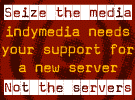About five people were able to gain access to the car park and, escorted by a few policemen, walked over to stand near the fence. When the rest of the group tried to join them by walking through a small gap in the police line, the chief warden of the prison came over and demanded to search the people at the front of the group. He suggested that in light of the current amber national security alert level, that he had a responsibility to search people to ensure the integrity of the prison security.
A heated discussion ensued, until the protestors backed off. The warden then moved back too. The police then confirmed again that the warden had no legal power to prevent the protestors from entering the car park, or to search them as a condition of entry.
Several of the ranking police at the scene and the chief warden, and another prison officer began a discussion out of earshot out of the solidarity group. With now around 35 people trying to gain access still being blocked by police and prison staff. After several minutes, a police inspector walked over and stated that he was going to use section 14 and would be back shortly to define it. He then walked away and a further discussion between various members of the police and prison staff could be seen. When he returned, he stated that he was employing section 14 as he was concerned that there might be a breach of the peace. He described the area in the car park that people would be allowed to demonstrate. The solidarity was not allowed up to the fence (obstensibly to keep the footpath alongside it clear), nor on the approach road to the main entrance to the prison. However, the area was still quite close to the main prison gates. The police set a limit of 5pm for the end of the demonstration.
The solidarity group then entered the car park. The five people near the fence where moved back into the defined area by the police.
The demonstrators made noise banging pans, clapping and shouting (and occasionally chanting). During the demonstration, around ten more people arrived and were able to enter the car park. a further group of approximately ten people arrived shortly after and was also able to enter the car park.
Two police photography teams arrived, along with at least four police vans, two marked police cars and a Land-Rover type vehicle. The police began filming and photographing everybody; surrounding the demonstration on three sides with a thin line.
Just before 5pm, about 25 police in black, with gloves and padding, but without sheilds or helmets, joined the 30 or so yellow-blue jacketed police, forming a U-shape around the group. The solidarity group slowly left the car park, followed by the police, who then blocked the entrance to the prison car park. Most of the group crossed the road. The police continued to film and pushed two people away from the entrance to the prison car park.
Some of the solidarity group then got on a bus into town. A second bus arrived, which most of the solidarity boarded. Approximately eight police also boarded the bus. As the bus drove off, three police vehicles followed, at least as far as Haymarket Station The vehicles were unmarked. The first two were full, and the third only had a driver. The lead police vehicle contained one of the photography teams. Several legal observers were also on the second bus.
